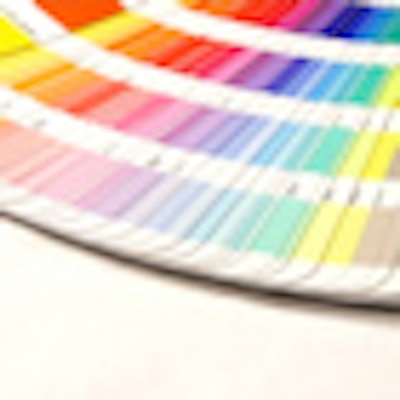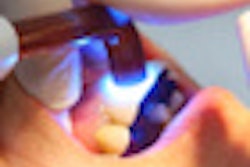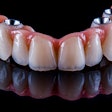
Good shade matching is tricky enough with porcelain. But a good shade match with composite materials can be an even bigger challenge.
A new study has found that composite shades do not match well to the Vita shade guide tabs (Vident), even when the layering technique is used (Journal of Esthetic and Restorative Dentistry, April 2010, Vol. 22:2, pp. 114-124).
Resin composite shade matching is very challenging for several reasons, according to lead author Juliana da Costa, D.D.S., an assistant professor in the department of restorative dentistry at the Oregon Health and Science University (OHSU) School of Dentistry.
“We were hoping that with 72 combinations, we were going to find better matches.”
— Juliana da Costa, D.D.S.
"The shade guides used by dentists were designed for porcelain, not for composite, and although several composites are keyed to a shade guide and have the same designation, they have poor color compatibility," she told DrBicuspid.com.
Also, composites of different brands that present the same shade designation present different shades, she added. For example, an A1 enamel shade from one composite brand might be more yellow and more opaque than another one.
"Despite the difficulty of truly matching a composite to a shade guide, this study aimed to find out which composites are truly keyed to the gold standard Vitapan Classical shade guide, taking into account the layering technique and different backgrounds," Dr. da Costa said.
Mimicking the layering technique
For this study, Dr. da Costa and colleagues from the OSHU dental school compared the final shade of different composites (enamel shades) over a white backing and black backing and a layering technique (enamel over dentin composite) with the corresponding Vita Classical shade.
This is the first study that tried to mimic the layering technique -- stacking dentin and enamel shade -- and compare it to the shade guide, Dr. da Costa said. Others have compared either enamel or dentin composite shades, but not both combined, to the shade guide.
The researchers made composite disk specimens of enamel and dentin shades, 8 mm in diameter and 1- to 1.5-mm thick. They evaluated four enamel shades: B1, B2, A1, and A2. Three dentin shade disks -- A1, A2, and A3 -- were fabricated and placed under the enamel shade disks to simulate the layering technique.
The researchers evaluated three commercial resin composites: 3M ESPE's Filtek Supreme Plus (FS), Kerr Dental's Premise (P), and Tokuyama's Estelite Sigma (ES).
The colors of the Vita B1, B2, A1, and A2; enamel shade disks; and layering composites of the same brand and different brands were assessed using a colorimeter over a white backing and black backing. The total color difference between the Vita disks and the corresponding resin composite disks was calculated.
Poor color match
The researchers found a poor color match when comparing the composite enamel shades of all brands with the Vita shades with no dentin backing, especially with the white backing. When the dentin shades were layered by the enamel shades to simulate the layering technique, some of the composites had a closer match to the Vita shades.
Overall, the brightness, color on a red green axis, and color on a yellow blue axis values of the enamel composite shades were significantly different from the corresponding Vita shade. A few layered composites matched the brightness and color values of the keyed Vita shade.
Only a few composites, ES enamel layered over ES dentin shades, and ES enamel layered over FS and P dentin shades, produced a good shade match when compared with the corresponding Vita shade, the authors concluded.
"We had an idea that composites do not match well to the keyed Vita shade tab, but we were hoping that with the 72 combinations of different composite brands and backgrounds, we were going to find better matches," Dr. da Costa said. "We were also surprised by how well Estelite Sigma matched to the shade guide."
Although the Vita Classical shade guide is a good starting point for determining the composite shade for the layering technique, clinicians need to be familiar with the composite they are using, Dr. da Costa said.
For example, this study showed that Estelite Sigma presents similar color to the shade guide, she said. Therefore, upon shade selection, if the base shade selected is similar to the shade guide, this composite might be a good match to the tooth being restored.
"If companies are keying their composites to the Vita shade guide, the composites should be as close as possible in color to it," Dr. da Costa added. "This study has shown that, overall for the composites evaluated, composites are lighter, more green, and more blue than the Vita shade guide."
Creating custom shade tabs
Todd Snyder, D.D.S., who has a private practice in Laguna Niguel, CA, and has conducted similar research (Practical Procedures and Aesthetic Dentistry, February. 2006, Vol. 18:1, pp. 55-60), said this study substantiates the already accepted fact that resin composite materials do not match well with shade guides.
This problem arises because shade guides might be made from different materials or even different batches of resin product than the ones being used by the dentist, he said.
So what is the solution?
Both he and Dr. da Costa suggest that, although the process can be time-consuming, clinicians can create custom shade tabs out of the composite they are using. But most dentists, except cosmetic dentists, may not want to invest that time, Dr. Snyder said.
Also, restorations placed on anterior teeth typically require a higher level of aesthetics, he added. The back teeth may not require the same level of aesthetics due to shadowing and the fact that they are relatively hidden.
Copyright © 2010 DrBicuspid.com



















